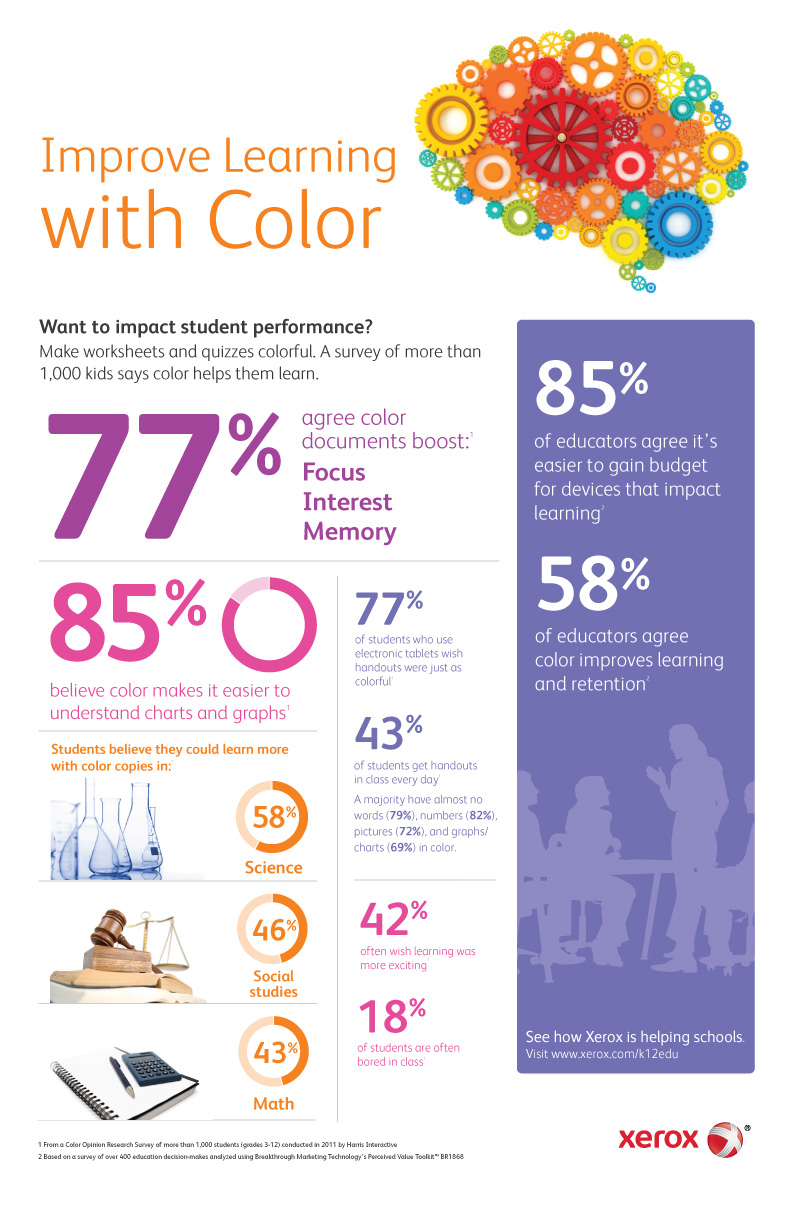By Shelly Dates, Communications Manager, Enterprise Business Group, Xerox
Children today are surrounded by technology, earning them the title of “The Digital Natives.” They have grown up with gadgets. They don’t remember a time before the Internet, smartphones and text messaging. Have you seen the YouTube video where a one-year-old girl is navigating her way around an iPad but is completely confused when her dad gives her a magazine? She doesn’t understand why the magazine won’t respond to her swipe and tap gestures. She even checks to make sure her finger is still working. Amazing. And all of this technology is in full, vibrant, often high-definition color.
When I was growing up, we had a small black and white television in our kitchen. If I told that to my 7- and 9-year-old children, I’m not sure they’d even understand what I meant. Today, color is not an option. It’s not a “nice to have.” It’s everywhere. Just look at the nearest parking lot to see the bright eye-catching colors car manufacturers are now using. Or walk into a Target store. You may have seen their latest commercial that declares, “Color Changes Everything.” The moment you walk into the store you’re facing a sea of incredibly bright, colorful products – from handbags to house wares – say goodbye to monochrome and hello to color!
Researchers have studied the effects of color – how it can stimulate the brain and how different colors can prompt different emotions. Interior decorators, graphic and web designers and advertisers well understand the impact of color. But does our school system value color?
Educators are absolutely focused on trying to improve student performance. U.S. Secretary of Education, Arne Duncan, called it a wake-up call when a 2009 study showed that students in the U.S. are falling behind other countries when it comes to math, reading and science. Out of 34 countries, the U.S. ranked 14th in reading, 17th in science and an even more concerning 25th in math.
At Xerox, we recently completed months of research to better understand the K-12 market. Teachers and school administrators will tell you their top priority is improving student performance. But do they consider the research of how color can stimulate learning? One teacher told me, “Sure, color is nice. But I’m focused on teaching my students to read and write. Now if you can tell me that color will help do that, you’ve got my interest.” So we asked students what they thought. And they overwhelmingly agree – color makes a difference.
We worked with Harris Interactive and surveyed more than 1,000 students, grades 3-12. An impressive 77 percent believe color would make schoolwork more interesting and would make it easier to focus on the important information, as well as remember it easier. Students also say color would help them learn more in complex subjects such as science. But seven in ten said currently, very few or none of their handouts they receive in class have pictures, charts or graphs in color.
I’m not suggesting that simply adding color to documents will put the U.S. Education system back on top; but perhaps it’s a piece of the puzzle. After all, today’s digital natives are used to seeing color in all the technology they use. They expect their homework to look just as interesting and appealing. And if it does, perhaps they’ll spend a little more time on their schoolwork before they rush off to play on their Nintendo DSi or iPad.
What do you think?
———-
This survey was conducted online within the United States by Harris Interactive on behalf of Xerox from Nov. 16-28, 2011 among 1,002 students in grades 3-12. Figures for age, sex, race/ethnicity, parental education, urbanicity and region were weighted where necessary to bring the overall sample into line with their actual proportions in the population of U.S. 8-18 year olds. Because the sample is based on those who agreed to be invited to participate in the Harris Interactive online research panel, no estimates of theoretical sampling error can be calculated.

